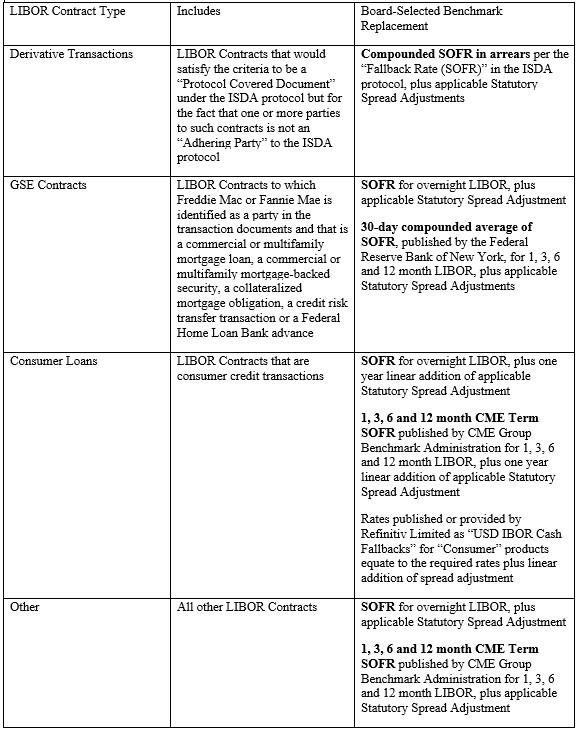31 Flavors of SOFR? Federal Reserve Proposes LIBOR Replacement Regulation
July 28, 2022
In celebration of National Ice Cream Month (or more likely, in response to the requirements of the Adjustable Interest Rate (LIBOR) Act1 (“LIBOR Act”)), the Board of Governors of the Federal Reserve (“Board”) released a proposed regulation on July 19, 2022, implementing the LIBOR Act. Whether you like vanilla or rocky road, the proposed regulation offers flavors of the Secured Overnight Financing Rate (“SOFR”) for everyone. Under the LIBOR Act, the Board is tasked with identifying the “Board-selected benchmark replacement” for LIBOR contracts covered by the Act (“LIBOR Contracts”). The Board-selected benchmark replacement must be based on SOFR and include the tenor-specific spread adjustments identified in the LIBOR Act and duplicated in the proposed regulation2 (“Statutory Spread Adjustments”). To that end, the Board proposed the following SOFR sweets:
Most of these proposed replacements mirror prior recommendations of the Alternative Reference Rates Committee. The categorization for GSE contracts caught a few by surprise; it allows the GSEs to align the rates of their legacy LIBOR transactions with their newer issuances, bolstering liquidity. Contrast that with other issuers whose covered legacy securitizations will fall back to CME Term SOFR, regardless of the rate used for newer issuances. The Board also added some proposed rainbow sprinkles (i.e., clarifications, interpretations and other musings on the meaning and scope of the LIBOR Act):
- To fulfill Congress’s intent that the LIBOR Act apply nationwide, the Board proposes to define “state” to include any state, commonwealth, territory, possession of the United States, the District of Columbia, the Commonwealth of Puerto Rico, the Commonwealth of the Northern Mariana Islands, American Samoa, Guam or the United State Virgin Islands. SOFR gelatos for everyone.
- The Board clarifies that the date for determining any Board-selected benchmark replacement is the day under the LIBOR Contract that would have been used to determine the LIBOR-based rate being replaced, or if the Board-selected benchmark replacement is not published on that day, the most recently available publication.
- The Board acknowledges in its commentary a potential issue related to non-covered LIBOR Contracts and the possibility of “synthetic” LIBOR. The Board noted that, if a contract contains a fallback to a non-LIBOR based benchmark replacement, it would not be considered a LIBOR Contract covered by the Act, should be enforced according to its terms and should not be affected by the LIBOR Act or the Board’s regulation. However, the UK Financial Conduct Authority (“FCA”) is soliciting comment for the potential publication of a “synthetic” LIBOR after the LIBOR replacement date. That synthetic LIBOR, similar to the synthetic LIBORS for sterling and yen, would likely be based on a term SOFR plus a spread adjustment and would be declared by the FCA to be “no longer representative of the underlying market.” If a contract’s fallback provision is triggered only when LIBOR is unavailable (and if the contract does not expressly require LIBOR to be representative of the market), then the contractual fallback provision might never be triggered as long as the nonrepresentative synthetic LIBOR is available, even though the parties—who likely never anticipated a synthetic LIBOR—might not have intended that. To ensure that the fallback provision would become operative if a synthetic LIBOR is published, the Board suggests that the final regulation could provide that, unless the parties expressly exempt the contract from the LIBOR Act, synthetic LIBOR would be replaced with the benchmark replacement identified in the contract on the LIBOR replacement date (or on the replacement date specified in the contract, if it is earlier). The Board believes this might be a useful clarification that would further the objectives of the LIBOR Act by reducing litigation. At the same time, however, the Board also recognized that because the LIBOR Act is silent on the effect of a nonrepresentative synthetic LIBOR, it would be reasonable to withhold any such clarification.
- The Board invited comments addressing the potential effect of a nonrepresentative synthetic LIBOR, as well as several other issues described in the Board’s commentary, including possible alternative SOFR flavors to those proposed, additional clarifications regarding contracts covered by the LIBOR Act and the authority of determining persons to select a benchmark replacement. Those comments are due 30 days after the proposed regulation is published in the Federal Register.
Hunton Andrews Kurth’s multi-disciplinary LIBOR transition client service team is available to assist clients navigating LIBOR transition, including consideration of and drafting for term SOFR and other replacement rates. For further information, contact any of the related people.
1 12 U.S.C. § 5801 et seq. signed into law on March 15, 2022.
2 0.00644 percent for overnight LIBOR, 0.11448 percent for one-month LIBOR, 0.26161 percent for three-month LIBOR, 0.42826 percent for six-month LIBOR and 0.71513 percent for 12-month LIBOR.

